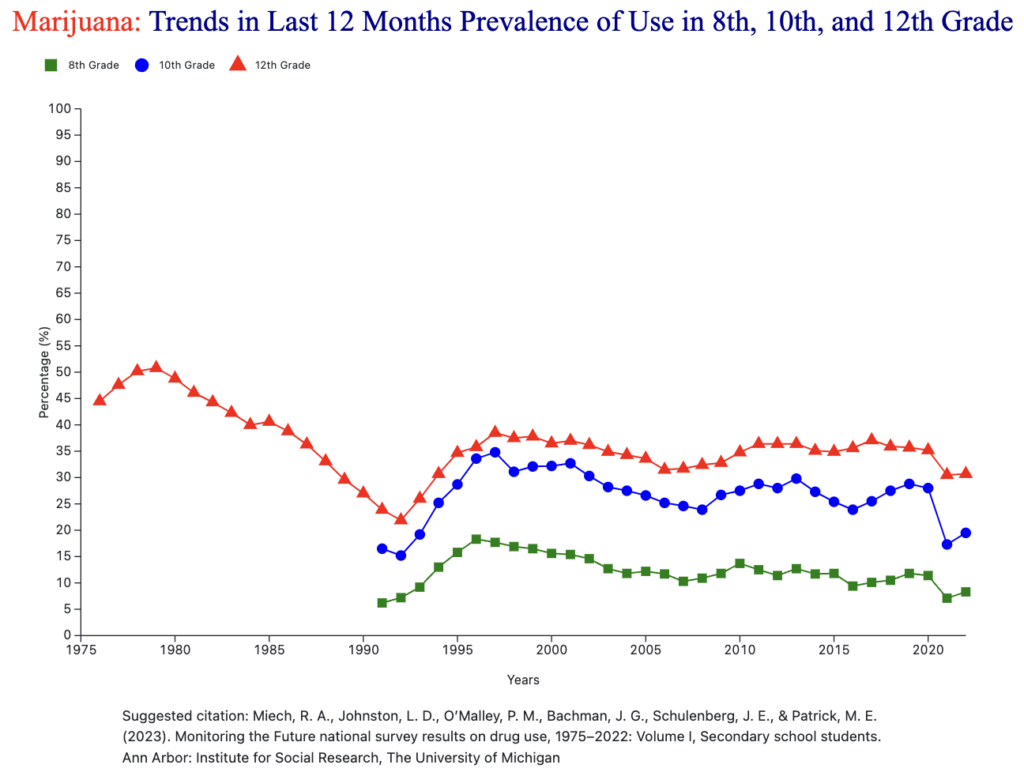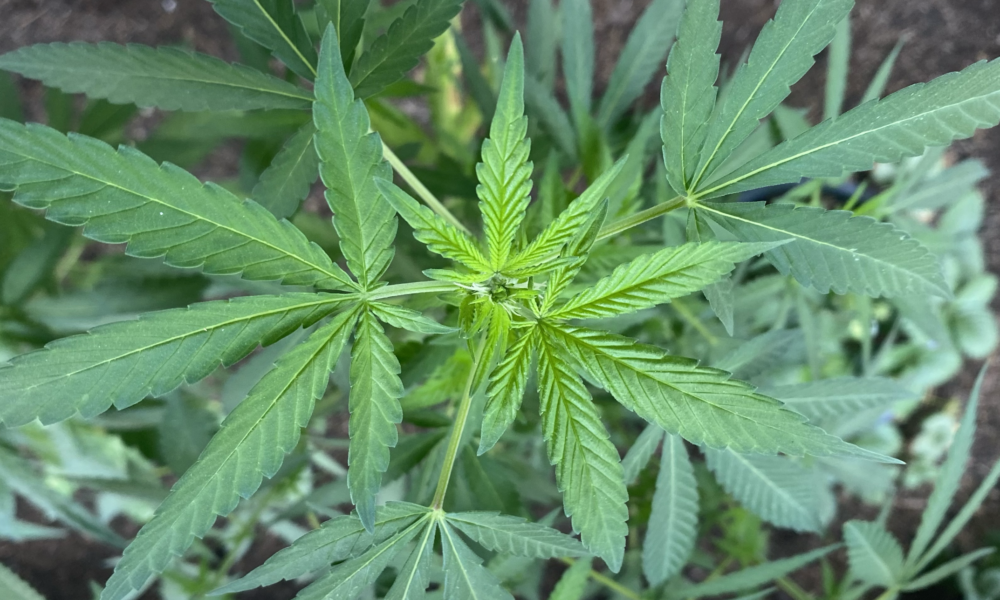Even as more states legalized marijuana—and society started to return to normal following the worst of the coronavirus pandemic by lifting restrictions that kept many students at home under parental supervision—teen cannabis use remained stable in 2022, according to the latest federally funded Monitoring the Future (MTF) Survey.
Experts like National Institute on Drug Abuse (NIDA) Director Nora Volkow had largely attributed an earlier substantial 2020 to 2021 drop in illicit substance use among youth to the fact that the pandemic minimized social interactions for many young people. The expectation was that there’d be a resurgence amid renewed socialization—but that didn’t happen last year according to the new data.
Instead, past-year, past-30 day and daily marijuana consumption among 8th, 10th and 12th graders went mostly unchanged in 2022.
Via MTF.
About five percent of those in 8th grade reported using cannabis in the past-month, which is just slightly higher than the 4.1 percent reported the prior year and still notably lower than the 6.5 percent level in 2020. It’s also substantially lower compared to the 11.3 percent peak in 1996—well before any adult-use markets had come online in states.
For 10th graders, past-month use was 12.1 percent. Again, that’s marginally higher than 2021 (10.1 percent), but much lower than 2020 (16.6 percent) and a far cry from the 1997 peak of 20.5 percent.
The same basic trend was observed for 12th graders, 20.2 percent of whom reported past-month marijuana consumption in 2022. In 2021, that rate was 19.5, compared to 37.1 percent in 1978.
“Cannabis use remained stable for all three grades surveyed,” a NIDA official told Marijuana Moment in an email on Thursday.
The official added: “Of note, 6.0 percent of eighth graders, 15.0 percent of 10th graders, and 20.6 percent of 12th graders reported vaping cannabis within the past year, reflecting a stable trend at the pre-pandemic level among eighth and 12th graders, and a small increase in reported use among 10th graders, though reported use among 10th graders in 2022 is still significantly below pre-pandemic levels.”
The same basic trend line was observed when teens were asked about past-year marijuana use as part of this latest MTF survey:

Via MTF.
In a press release, NIDA’s Volkow said that MTF, which was been analyzing youth substance use trends for nearly 50 years, is “one of the best and most timely tools we have to monitor and understand changes in substance use among young people over time, including through historic events such as the COVID-19 pandemic.”
“It is encouraging that we did not observe a significant increase in substance use in 2022, even as young people largely returned to in-person school, extracurricular activities, and other social engagements,” she said.
Nicotine vaping, alcohol use and consumption of other illicit substances also generally “remained stable” across most age groups, MTF found. There were some exceptions, however. For example, alcohol use among 12th graders “returned to pre-pandemic levels,” as did consumption of opioids other than heroin.
A slideshow that was presented at a NIDA briefing on the MTF findings did show that past-year cannabis use were slightly higher—and disapproval of marijuana consumption was somewhat lower—among students living in states where medical cannabis was legal—a point that Smart Approaches to Marijuana (SAM) President Kevin Sabet highlighted.
On todays @NIDAnews briefing—
8th, 10th and 12th graders living in medical marijuana states:
Past year use, availability is ⬆️
Disapproval and risk belief is ⬇️
“Legal states” likely even worse.
When will we learn? pic.twitter.com/87RFtu5s4o
— Kevin Sabet (@KevinSabet) December 15, 2022
It’s not clear what criteria NIDA used to classify states as either having medical cannabis or not, as some counts include those with more restrictive programs while others don’t.
Meanwhile, past-month marijuana vaping among 12th graders ticked up at a statistically significant level from 2021 to 2022, another slide shows.

Via NIDA/MTF.
But the overall consistency bucks the increasingly debunked argument from prohibitionists that legalization would lead to a surge in underage use.
The University of Michigan’s Institute for Social Research, which conducts the annual survey for NIDA, focused on teen vaping trends in its press release, omitting mention of marijuana unlike in past summaries.
But while it might be somewhat surprising that young marijuana use didn’t increase after pandemic restrictions were lifted as some expected, the general finding that teen consumption is stable is consistent with a growing body of scientific literature on the topic.
Just last month, for example, another NIDA-funded study that was published in the American Journal of Preventive Medicine found that state-level cannabis legalization is not associated with increased youth use.
The study demonstrated that “youth who spent more of their adolescence under legalization were no more or less likely to have used cannabis at age 15 years than adolescents who spent little or no time under legalization.”
Yet another federally funded study from Michigan State University researchers that was published in the journal PLOS One this summer found that “cannabis retail sales might be followed by the increased occurrence of cannabis onsets for older adults” in legal states, “but not for underage persons who cannot buy cannabis products in a retail outlet.”
Meanwhile, adolescent marijuana use in Colorado declined significantly in 2021, according to the latest version of a biennial state survey released in June.
Advocates have long argued that providing regulated access to marijuana at stores where there are requirements to check ID, for example, would mitigate the risk of adolescent consumption.
A recent study out of California found that “there was 100 percent compliance with the ID policy to keep underage patrons from purchasing marijuana directly from licensed outlets.”
The Coalition for Cannabis Policy, Education, and Regulation (CPEAR), an alcohol and tobacco industry-backed marijuana policy group, also released a report this year analyzing data on youth marijuana use rates amid the state-level legalization movement.
Another federally funded study, the National Survey on Drug Use and Health (NSDUH), was released in October showing that youth marijuana use dropped in 2020 amid the coronavirus pandemic and as more states moved to enact legalization.
Further, an analysis published by the Journal of the American Medical Association last year found that enacting legalization has an overall impact on adolescent cannabis consumption that is “statistically indistinguishable from zero.”
The U.S. Department of Education’s National Center for Education Statistics also analyzed youth surveys of high school students from 2009 to 2019 and concluded that there’s been “no measurable difference” in the percentage of those in grades 9-12 who reported consuming cannabis at least once in the past 30 days.
In a separate, earlier analysis, the Centers for Disease Control and Prevention found that marijuana consumption among high school students declined during the peak years of state-legal recreational cannabis legalization.
There was “no change” in the rate of current cannabis use among high school students from 2009-2019, the survey found. When analyzed using a quadratic change model, however, lifetime marijuana consumption decreased during that period.
Another study released by Colorado officials in 2020 showed that youth cannabis consumption in the state “has not significantly changed since legalization” in 2012, though methods of consumption are diversifying.
An official with the White House Office of National Drug Control Policy’s National Marijuana Initiative went even further in 2020, admitting that, for reasons that are unclear, youth consumption of cannabis “is going down” in Colorado and other legalized states and that it’s “a good thing” even if “we don’t understand why.”
Kansas Lawmakers Hold Final Medical Marijuana Meeting After Touring Grow Facility, With Chairman Previewing 2023 Bill Plans
Read the full article here









